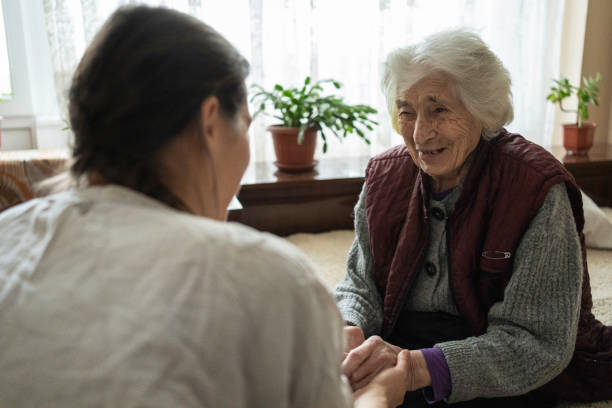In-Home Rehabilitation Services for Senior Independence
In-home rehabilitation services play a crucial role in supporting the independence and well-being of seniors. By providing personalized care and therapy in the comfort of their own homes, these services offer numerous benefits that contribute to a more effective recovery process and improved quality of life.
The Importance of In-Home Rehabilitation
In-home rehabilitation services, as highlighted by Episcopal Retirement Services, provide personalized support and care tailored to the specific needs and goals of senior individuals. This individualized approach allows seniors to receive the attention and treatment they require, leading to a more effective recovery process.
Recovering in familiar surroundings is a significant advantage of in-home rehabilitation services. According to Episcopal Retirement Services, seniors benefit from being in a comfortable and familiar environment, which positively impacts their mental and emotional well-being. By avoiding the stress and unfamiliarity of a clinical setting, seniors can focus on their rehabilitation and experience a sense of security and reassurance.
Benefits of In-Home Rehabilitation Services
In-home rehabilitation services, provided by organizations like Home Advantage Rehabilitation, offer a range of benefits for seniors seeking to regain their independence and improve their overall well-being.
Personalized Care Plans
In-home rehabilitation services enable seniors to receive personalized care plans tailored to their specific needs. This individualized approach allows for targeted therapy and support, maximizing the effectiveness of the rehabilitation process. Seniors can receive one-on-one attention from skilled professionals, progress at their own pace, and work towards their unique goals.
Improved Balance and Fall Prevention
In-home physical therapy services, as highlighted by Home Advantage Rehabilitation, focus on improving balance, strength, and mobility. This targeted approach helps seniors reduce the risk of falls and enhances their overall safety and independence. Particularly beneficial after a hospital stay or surgery, in-home rehabilitation services provide seniors with the tools and exercises needed to regain their balance and confidence.
By removing the need for transportation to and from a clinic, in-home rehabilitation services, as emphasized by Parentis Health, offer convenience for seniors. They can receive therapy in the comfort of their own homes, eliminating the stress and logistical challenges associated with traveling to a clinic. This convenience factor contributes to increased participation and commitment to the rehabilitation process.
Active Involvement of Family Caregivers
In-home physical therapy significantly boosts seniors’ motivation and participation levels, as mentioned by Givers. By receiving care in a familiar setting, seniors are more likely to actively engage in rehabilitation. Additionally, family caregivers can actively participate in the therapy process, providing support and encouragement. The presence of loved ones during therapy sessions can enhance the overall experience and further contribute to seniors’ independence and quality of life.
In-home rehabilitation services offer a tailored approach to care, addressing seniors’ specific needs and goals. By providing personalized treatment plans and promoting a faster and successful recovery process, these services empower seniors to regain their independence and improve their overall well-being. The convenience, familiarity, and active involvement of family caregivers make in-home rehabilitation an invaluable resource for seniors on their path to independence.
Components of In-Home Rehabilitation
In-home rehabilitation services play a vital role in supporting senior independence by providing personalized care and therapy in the comfort of their own homes. Two key components of in-home rehabilitation are personalized treatment plans and skilled geriatric physical therapists.
Personalized Treatment Plans
When seniors opt for in-home rehabilitation services, they can expect to receive personalized treatment plans tailored to their individual needs and goals. These treatment plans are developed after an initial assessment, which takes into account the senior’s physical condition, medical history, and living environment.
The personalized treatment plans include specific exercises, activities, and potential home modifications to enhance safety and independence. The focus is on improving movement, pain control, and overall quality of life for seniors. By customizing the treatment plan to address the unique challenges and goals of each senior, in-home rehabilitation services can maximize the effectiveness of the therapy.
Skilled Geriatric Physical Therapists
In-home rehabilitation services are provided by skilled geriatric physical therapists who specialize in working with older adults. These therapists have the expertise and experience to address the unique needs and concerns of seniors, ensuring that they receive the highest quality care.
Geriatric physical therapists are trained to assess the physical capabilities and limitations of seniors, taking into account age-related changes and conditions that may impact their rehabilitation process. They are well-versed in designing and implementing appropriate exercise programs, balance training, and mobility exercises to promote functional independence.
With their knowledge of geriatric care and rehabilitation techniques, these therapists can provide seniors with the support and guidance they need to regain mobility, improve strength, and enhance their overall quality of life. The presence of skilled geriatric physical therapists ensures that seniors receive the necessary expertise and attention to facilitate a faster and more successful recovery process.
By combining personalized treatment plans with the expertise of skilled geriatric physical therapists, in-home rehabilitation services offer a comprehensive approach to supporting senior independence. These components work together to promote mobility, improve strength, and enhance overall well-being, enabling seniors to regain their independence and maintain a high quality of life.
Enhancing Independence through In-Home Rehabilitation
In-home rehabilitation services play a crucial role in enhancing the independence of seniors by focusing on improving various aspects of their physical well-being. Two key areas that are targeted through in-home rehabilitation are balance and fall prevention, as well as strength and mobility.
Improving Balance and Fall Prevention
Falls are a significant concern for seniors, as they can lead to serious injuries and a loss of independence. In-home rehabilitation services are designed to address this issue by implementing strategies to improve balance and prevent falls.
Through personalized treatment plans, skilled geriatric physical therapists work with seniors to assess their balance and identify areas of improvement. They then develop exercises and techniques tailored to the individual’s specific needs. These exercises often focus on strengthening the core muscles, improving coordination, and promoting stability.
By consistently engaging in these exercises, seniors can enhance their balance and reduce the risk of falls. This, in turn, allows them to maintain their independence and navigate their daily lives with confidence.
Enhancing Strength and Mobility
Loss of strength and mobility is a common issue among seniors, which can greatly impact their ability to perform daily activities and maintain independence. In-home rehabilitation services aim to address these challenges by targeting strength and mobility through targeted exercises and therapies.
Physical therapists work closely with seniors to develop personalized treatment plans that focus on improving strength and enhancing mobility. These plans may include exercises that target different muscle groups, range-of-motion exercises, and functional activities to improve overall physical function.
By regularly participating in these exercises, seniors can experience significant improvements in their strength and mobility. This can lead to enhanced independence in performing tasks such as walking, climbing stairs, and engaging in activities of daily living.
Through in-home rehabilitation services, seniors are empowered to regain control over their physical well-being, thereby increasing their independence and reducing the risk of falls and injuries.
In conclusion, in-home rehabilitation services for seniors provide targeted interventions to improve balance, prevent falls, and enhance strength and mobility. By addressing these key areas, seniors can experience a significant improvement in their overall quality of life and maintain their independence for longer periods.
Advantages of In-Home Rehabilitation Services
In-home rehabilitation services for seniors offer numerous advantages that contribute to their overall well-being, independence, and successful recovery. Let’s explore two key advantages: convenience and familiarity, and the active involvement of family caregivers.
Convenience and Familiarity
One of the significant benefits of in-home rehabilitation services is the convenience they provide. Seniors can receive therapy in the comfort of their own homes, minimizing the need for frequent transportation to medical facilities, which can be challenging for individuals with limited mobility or access to transportation [4]. This convenience not only saves time and effort but also reduces the stress associated with traveling to appointments.
Furthermore, receiving rehabilitation services at home allows seniors to remain in familiar surroundings. Being in a familiar environment can have a positive impact on their mental and emotional well-being. The comfort of home promotes relaxation and a sense of security, creating a conducive atmosphere for healing and progress.
Active Involvement of Family Caregivers
Another advantage of in-home rehabilitation services is the active involvement of family caregivers in the care process. Family members can play a vital role in supporting and encouraging seniors during their recovery journey . Their presence provides emotional support, motivation, and reassurance, which can significantly impact the senior’s progress and overall well-being.
Family caregivers can actively participate in therapy sessions, learning techniques and exercises that they can assist with outside of scheduled sessions. This involvement allows for continuity of care and promotes a collaborative approach to the senior’s rehabilitation journey. By working together with the rehabilitation team, family caregivers can contribute to the senior’s successful recovery and help them regain independence.
The active involvement of family caregivers also enhances communication between the rehabilitation team, seniors, and their loved ones. This open line of communication ensures that everyone is well-informed about the progress, challenges, and goals, fostering a supportive environment for the senior’s rehabilitation journey.
By providing convenience, familiarity, and the active involvement of family caregivers, in-home rehabilitation services for seniors offer a holistic approach to their recovery. These advantages contribute to the overall success of the rehabilitation process, enabling seniors to regain their independence, improve their quality of life, and thrive in the comfort of their own homes.
The Impact of In-Home Rehabilitation
In-home rehabilitation services have a significant impact on the well-being and quality of life for seniors. By receiving rehabilitation in the comfort of their own homes, seniors experience various positive outcomes, including improved mental and emotional well-being and the ability to regain independence.
Improved Mental and Emotional Well-being
Recovering in familiar surroundings can have a positive effect on the mental and emotional well-being of seniors. The sense of comfort and security provided by their own homes can contribute to reduced stress levels and improved overall mood. Being surrounded by familiar belongings and memories can create a supportive environment that promotes a sense of normalcy during the rehabilitation process.
Additionally, in-home rehabilitation services often involve personalized support and care tailored to the specific needs and goals of the senior. This individualized attention can enhance motivation and engagement, leading to increased satisfaction and a more positive outlook on the recovery journey. The active involvement of family caregivers, who can provide emotional support and encouragement, also plays a crucial role in fostering a positive mindset and improved well-being during the rehabilitation process.
Regaining Independence and Quality of Life
One of the primary goals of in-home rehabilitation services is to help seniors regain their independence and improve their overall quality of life. Through targeted interventions, such as exercises, gait training, pain management, fall prevention strategies, and education on performing daily tasks safely, seniors can regain mobility, strength, and confidence in their abilities.
By addressing specific needs and goals, in-home rehabilitation services provide a tailored approach to support seniors in their recovery process. This individualized care enables seniors to progress at their own pace and receive the necessary attention to achieve optimal outcomes. As seniors regain their physical abilities, they experience a renewed sense of independence, allowing them to engage in activities they may have previously struggled with. This newfound independence contributes to an improved overall quality of life and a greater sense of fulfillment.
In-home rehabilitation services empower seniors to continue living in the comfort and familiarity of their own homes while receiving the necessary support to regain their independence and enhance their well-being. By addressing both physical and emotional aspects, these services play a vital role in promoting a successful recovery process and improving the overall quality of life for seniors.
Tailored Approach to In-Home Rehabilitation
In-home rehabilitation services offer a tailored approach to senior care, addressing specific needs and goals to promote a faster and successful recovery process. These personalized services enable seniors to receive individualized attention and progress at their own pace in the comfort of their homes [4].
Addressing Specific Needs and Goals
One of the key advantages of in-home rehabilitation services is the ability to address the specific needs and goals of each senior individual. The rehabilitation professionals work closely with the seniors to understand their unique challenges, limitations, and aspirations. Based on this assessment, a personalized treatment plan is developed to target the areas that require attention and improvement.
By tailoring the rehabilitation program to the specific needs and goals of seniors, the in-home therapists can focus on enhancing the areas that are most important to the individual’s overall well-being. Whether it’s regaining mobility after surgery, improving balance to prevent falls, or enhancing strength for daily activities, the treatment plan is designed to address these specific objectives.
Promoting a Faster and Successful Recovery Process
In-home rehabilitation services play a crucial role in promoting a faster and successful recovery process for seniors. By receiving care in the comfort of their own homes, seniors are in a familiar and supportive environment that can contribute to their overall well-being and comfort. This familiarity can help reduce anxiety and stress, which can be common during the recovery process.
Additionally, receiving in-home rehabilitation allows seniors to maintain their daily routines and activities. This level of independence and autonomy can have a positive impact on their mental and emotional well-being, further contributing to the overall success of the recovery process.
The tailored approach of in-home rehabilitation services ensures that seniors receive the necessary support and guidance to achieve their goals. The therapists work closely with the seniors, monitoring progress and making adjustments to the treatment plan as needed. This personalized attention and continuous evaluation contribute to a more effective recovery process, enabling seniors to regain their independence and enjoy an improved quality of life.
Through a combination of addressing specific needs and goals and promoting a faster and successful recovery process, in-home rehabilitation services provide seniors with the individualized care and support they need to thrive in their own homes.
Challenges and Considerations
While in-home rehabilitation services for senior independence offer numerous benefits, there are certain challenges and considerations that need to be addressed, particularly in rural areas.
Workforce and Training Challenges in Rural Areas
One significant challenge in providing in-home rehabilitation services in rural areas is the presence of workforce and training challenges. This includes factors such as low wages for workers, high turnover rates, heavier workloads, and the need for specialized training to address complex medical and behavioral needs of recipients. The limited availability of skilled professionals in rural areas can make it difficult to provide adequate in-home rehabilitation services to seniors who require them.
Lack of Home-Based Services in Rural Communities
Another challenge in rural areas is the lack of home-based services and community supports. This can result in increased stress for informal caregivers, difficulty accessing healthcare due to limited transportation options, and a higher likelihood of using skilled nursing facilities. The absence of essential home-based services in rural communities not only affects seniors but also places a heavier burden on family caregivers who may have to take on additional responsibilities.
Studies have shown that the lack of home-based services in rural areas can lead to increased reliance on family caregivers, which may result in caregiver burden, disruption of their own well-being and social activities, and an increased risk for physical health problems and premature mortality. It is essential to recognize the critical role of family caregivers and provide them with the necessary support to ensure their well-being and the well-being of the seniors they care for.
To address these challenges, it is crucial to implement strategies that focus on creating a supportive environment for in-home rehabilitation services in rural areas. This includes initiatives to attract and retain skilled professionals, providing adequate training and support, and improving access to transportation options for seniors in need of rehabilitation services. Additionally, efforts should be made to enhance community supports and resources in rural areas, ensuring that seniors and their caregivers have access to the necessary services and assistance to maintain independence and quality of life.
By recognizing and addressing the challenges specific to rural areas, it is possible to overcome barriers and ensure that seniors in these communities have equal access to the in-home rehabilitation services they need to enhance their independence and overall well-being.
References
- https://www.joingivers.com/learn/in-home-physical-therapy
- https://homeadvantagerehab.com/in-home-physical-therapy-for-seniors
- https://parentishealth.com/benefits-of-in-home-physical-therapy-for-seniors/
- https://www.ruralhealthinfo.org/topics/community-living
- https://www.ncbi.nlm.nih.gov/pmc/articles/PMC2597573/



